Preface
Brief Contents
Contents
Ch 1: Introduction to Modeling and Decision Analysis
1.0: Introduction
1.1: The Modeling Approach to Decision Making
1.2: Characteristics and Benefits of Modeling
1.3: Mathematical Models
1.4: Categories of Mathematical Models
1.5: Business Analytics and the Problem-Solving Process
1.6: Anchoring and Framing Effects
1.7: Good Decisions vs. Good Outcomes
1.8: Summary
1.9: References
Ch 2: Introduction to Optimization and Linear Programming
2.0: Introduction
2.1: Applications of Mathematical Optimization
2.2: Characteristics of Optimization Problems
2.3: Expressing Optimization Problems Mathematically
2.4: Mathematical Programming Techniques
2.5: An Example LP Problem
2.6: Formulating LP Models
2.7: Summary of the LP Model for the Example Problem
2.8: The General Form of an LP Model
2.9: Solving LP Problems: An Intuitive Approach
2.10: Solving LP Problems: A Graphical Approach
2.11: Special Conditions in LP Models
2.12: Summary
2.13: References
Ch 3: Modeling and Solving LP Problems in a Spreadsheet
3.0: Introduction
3.1: Spreadsheet Solvers
3.2: Solving LP Problems in a Spreadsheet
3.3: The Steps in Implementing an LP Model in a Spreadsheet
3.4: A Spreadsheet Model for the Blue Ridge Hot Tubs Problem
3.5: How Solver Views the Model
3.6: Using Analytic Solver Platform
3.7: Using Excel's Built-In Solver
3.8: Goals and Guidelines for Spreadsheet Design
3.9: Make vs. Buy Decisions
3.10: An Investment Problem
3.11: A Transportation Problem
3.12: A Blending Problem
3.13: A Production and Inventory Planning Problem
3.14: A Multiperiod Cash-Flow Problem
3.15: Data Envelopment Analysis
3.16: Summary
3.17: References
Ch 4: Sensitivity Analysis and the Simplex Method
4.0: Introduction
4.1: The Purpose of Sensitivity Analysis
4.2: Approaches to Sensitivity Analysis
4.3: An Example Problem
4.4: The Answer Report
4.5: The Sensitivity Report
4.6: The Limits Report
4.7: Ad Hoc Sensitivity Analysis
4.8: Robust Optimization
4.9: The Simplex Method
4.10: Summary
4.11: References
Ch 5: Network Modeling
5.0: Introduction
5.1: The Transshipment Problem
5.2: The Shortest Path Problem
5.3: The Equipment Replacement Problem
5.4: Transportation/Assignment Problems
5.5: Generalized Network Flow Problems
5.6: Maximal Flow Problems
5.7: Special Modeling Considerations
5.8: Minimal Spanning Tree Problems
5.9: Summary
5.10: References
Ch 6: Integer Linear Programming
6.0: Introduction
6.1: Integrality Conditions
6.2: Relaxation
6.3: Solving the Relaxed Problem
6.4: Bounds
6.5: Rounding
6.6: Stopping Rules
6.7: Solving ILP Problems Using Solver
6.8: Other ILP Problems
6.9: An Employee Scheduling Problem
6.10: Binary Variables
6.11: A Capital Budgeting Problem
6.12: Binary Variables and Logical Conditions
6.13: The Fixed-Charge Problem
6.14: Minimum Order/Purchase Size
6.15: Quantity Discounts
6.16: A Contract Award Problem
6.17: The Branch-and-Bound Algorithm (Optional)
6.18: Summary
6.19: References
Ch 7: Goal Programming and Multiple Objective Optimization
7.0: Introduction
7.1: Goal Programming
7.2: A Goal Programming Example
7.3: Comments about Goal Programming
7.4: Multiple Objective Optimization
7.5: An MOLP Example
7.6: Comments on MOLP
7.7: Summary
7.8: References
Ch 8: Nonlinear Programming and Evolutionary Optimization
8.0: Introduction
8.1: The Nature of NLP Problems
8.2: Solution Strategies for NLP Problems
8.3: Local vs. Global Optimal Solutions
8.4: Economic Order Quantity Models
8.5: Location Problems
8.6: Nonlinear Network Flow Problem
8.7: Project Selection Problems
8.8: Optimizing Existing Financial Spreadsheet Models
8.9: The Portfolio Selection Problem
8.10: Sensitivity Analysis
8.11: Solver Options for Solving NLPs
8.12: Evolutionary Algorithms
8.13: Forming Fair Teams
8.14: The Traveling Salesperson Problem
8.15: Summary
8.16: References
Ch 9: Regression Analysis
9.0: Introduction
9.1: An Example
9.2: Regression Models
9.3: Simple Linear Regression Analysis
9.4: Defining "Best Fit"
9.5: Solving the Problem Using Solver
9.6: Solving the Problem Using the Regression Tool
9.7: Evaluating the Fit
9.8: The R2 Statistic
9.9: Making Predictions
9.10: Statistical Tests for Population Parameters
9.11: Introduction to Multiple Regression
9.12: A Multiple Regression Example
9.13: Selecting the Model
9.14: Making Predictions
9.15: Binary Independent Variables
9.16: Statistical Tests for the Population Parameters
9.17: Polynomial Regression
9.18: Summary
9.19: References
Ch 10: Data Mining
10.0: Introduction
10.1: Data Mining Overview
10.2: Classification
10.3: Classification Data Partitioning
10.4: Discriminant Analysis
10.5: Logistic Regression
10.6: k-Nearest Neighbor
10.7: Classification Trees
10.8: Neural Networks
10.9: Naive Bayes
10.10: Comments on Classification
10.11: Prediction
10.12: Association Rules (Affinity Analysis)
10.13: Cluster Analysis
10.14: Time Series
10.15: Summary
10.16: References
Ch 11: Time Series Forecasting
11.0: Introduction
11.1: Time Series Methods
11.2: Measuring Accuracy
11.3: Stationary Models
11.4: Moving Averages
11.5: Weighted Moving Averages
11.6: Exponential Smoothing
11.7: Seasonality
11.8: Stationary Data with Additive Seasonal Effects
11.9: Stationary Data with Multiplicative Seasonal Effects
11.10: Trend Models
11.11: Double Moving Average
11.12: Double Exponential Smoothing (Holt's Method)
11.13: Holt-Winter's Method for Additive Seasonal Effects
11.14: Holt-Winter's Method for Multiplicative Seasonal Effects
11.15: Modeling Time Series Trends Using Regression
11.16: Linear Trend Model
11.17: Quadratic Trend Model
11.18: Modeling Seasonality with Regression Models
11.19: Adjusting Trend Predictions with Seasonal Indices
11.20: Seasonal Regression Models
11.21: Combining Forecasts
11.22: Summary
11.23: References
Ch 12: Introduction to Simulation Using Analytic Solver Platform
12.0: Introduction
12.1: Random Variables and Risk
12.2: Why Analyze Risk?
12.3: Methods of Risk Analysis
12.4: A Corporate Health Insurance Example
12.5: Spreadsheet Simulation Using Analytic Solver Platform
12.6: Random Number Generators
12.7: Preparing the Model for Simulation
12.8: Running the Simulation
12.9: Data Analysis
12.10: The Uncertainty of Sampling
12.11: Interactive Simulation
12.12: The Benefits of Simulation
12.13: Additional Uses of Simulation
12.14: A Reservation Management Example
12.15: An Inventory Control Example
12.16: A Project Selection Example
12.17: A Portfolio Optimization Example
12.18: Summary
12.19: References
Ch 13: Queuing Theory
13.0: Introduction
13.1: The Purpose of Queuing Models
13.2: Queuing System Configurations
13.3: Characteristics of Queuing Systems
13.4: Kendall Notation
13.5: Queuing Models
13.6: The M/M/s Model
13.7: The M/M/s Model with Finite Queue Length
13.8: The M/M/s Model with Finite Population
13.9: The M/G/1 Model
13.10: The M/D/1 Model
13.11: Simulating Queues and the Steady-State Assumption
13.12: Summary
13.13: References
Ch 14: Decision Analysis
14.0: Introduction
14.1: Good Decisions vs. Good Outcomes
14.2: Characteristics of Decision Problems
14.3: An Example
14.4: The Payoff Matrix
14.5: Decision Rules
14.6: Nonprobabilistic Methods
14.7: Probabilistic Methods
14.8: The Expected Value of Perfect Information
14.9: Decision Trees
14.10: Creating Decision Trees with Analytic Solver Platform
14.11: Multistage Decision Problems
14.12: Sensitivity Analysis
14.13: Using Sample Information in Decision Making
14.14: Computing Conditional Probabilities
14.15: Utility Theory
14.16: Multicriteria Decision Making
14.17: The Multicriteria Scoring Model
14.18: The Analytic Hierarchy Process
14.19: Summary
14.20: References
Ch 15: Project Management
15.0: Introduction
15.1: An Example
15.2: Creating the Project Network
15.3: CPM: An Overview
15.4: The Forward Pass
15.5: The Backward Pass
15.6: Determining the Critical Path
15.7: Project Management Using Spreadsheets
15.8: Gantt Charts
15.9: Project Crashing
15.10: PERT: An Overview
15.11: Simulating Project Networks
15.12: Microsoft Project
15.13: Summary
15.14: References
Index
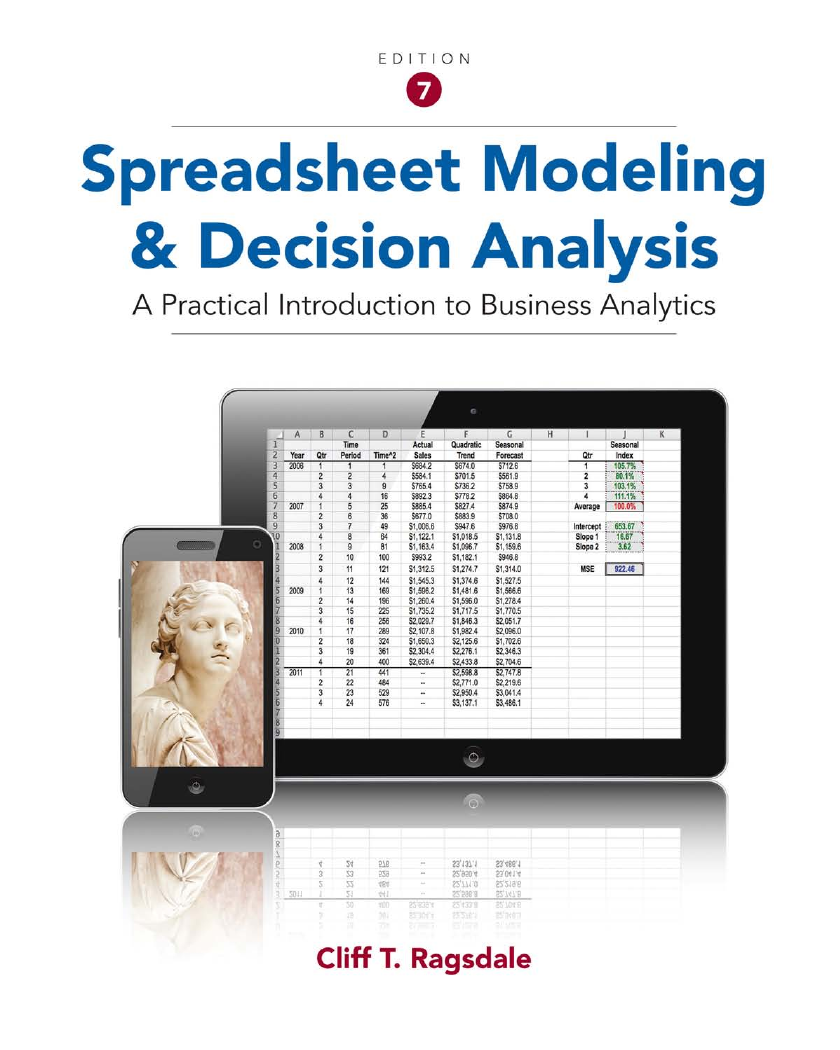
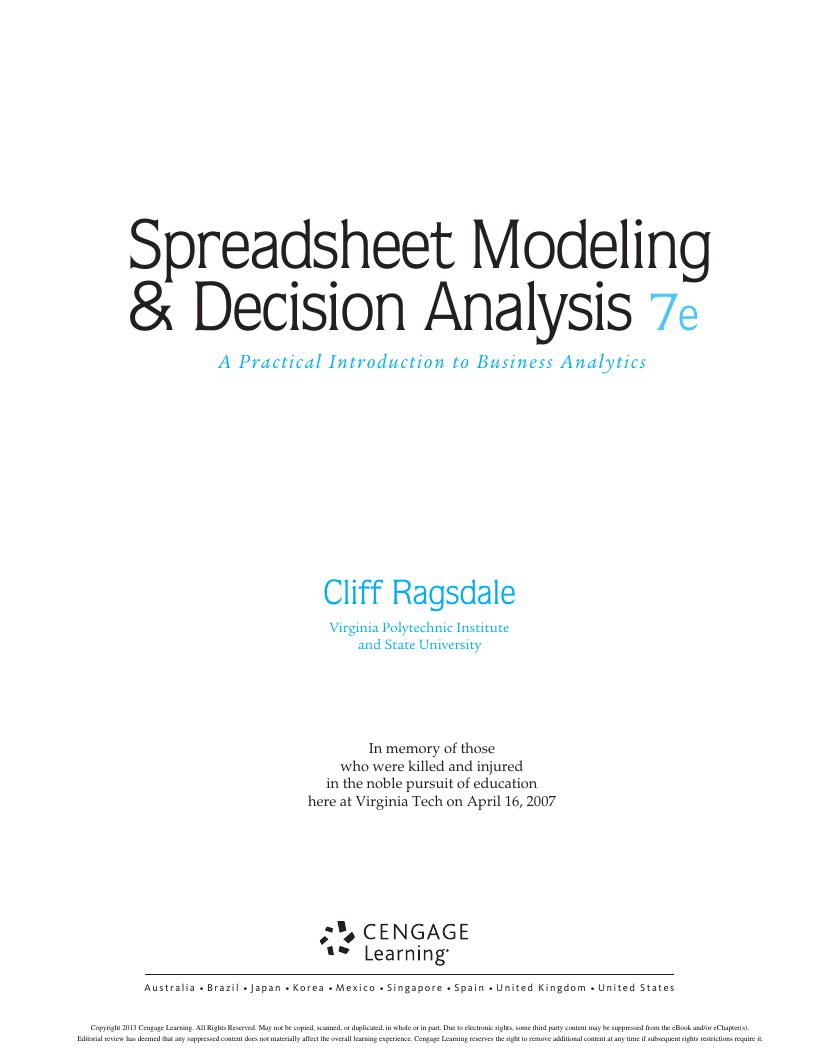


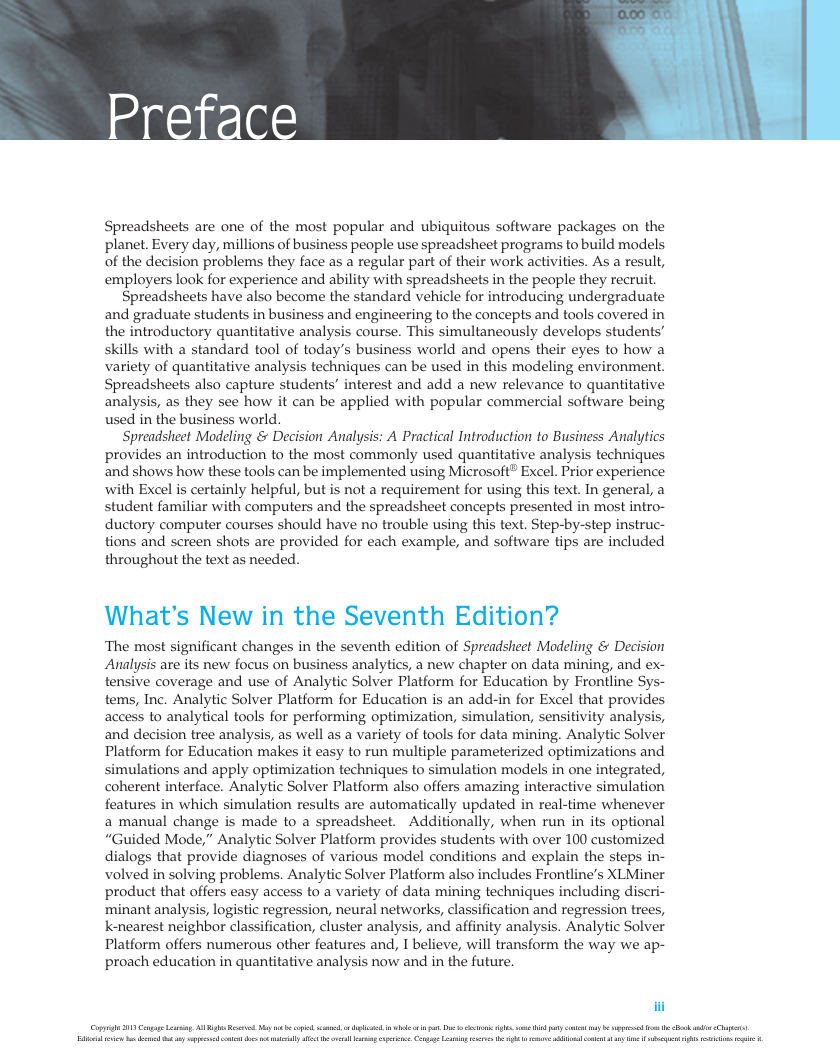
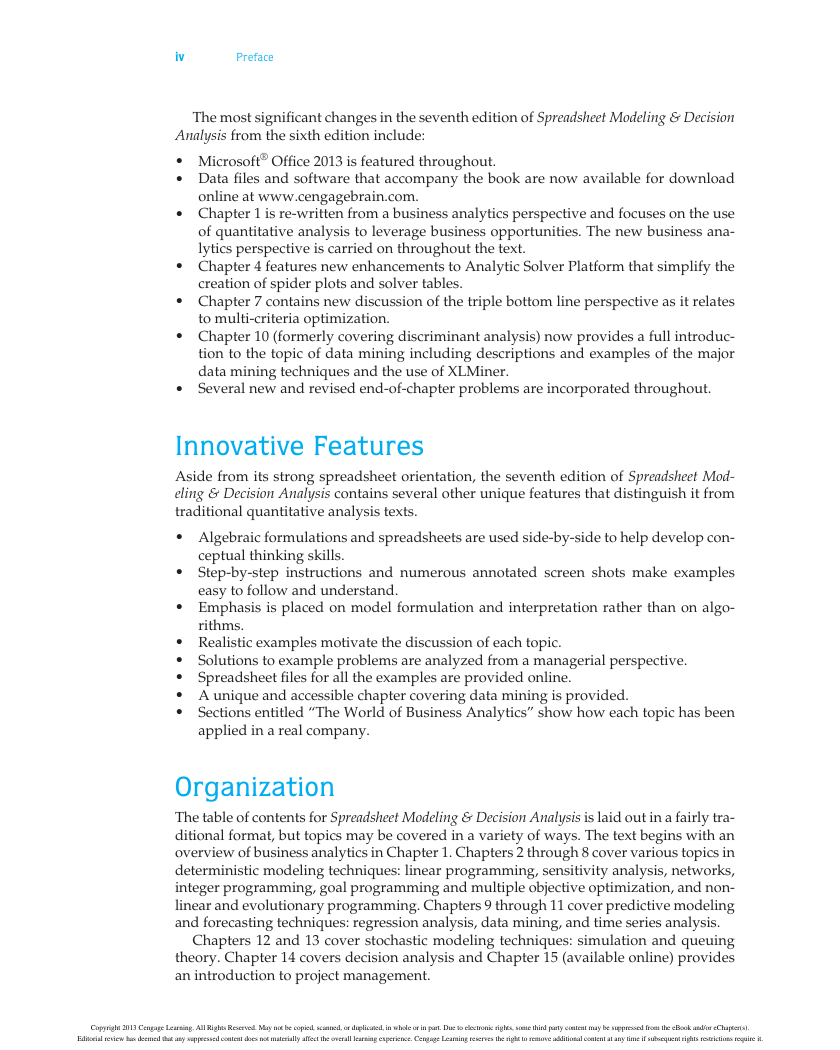
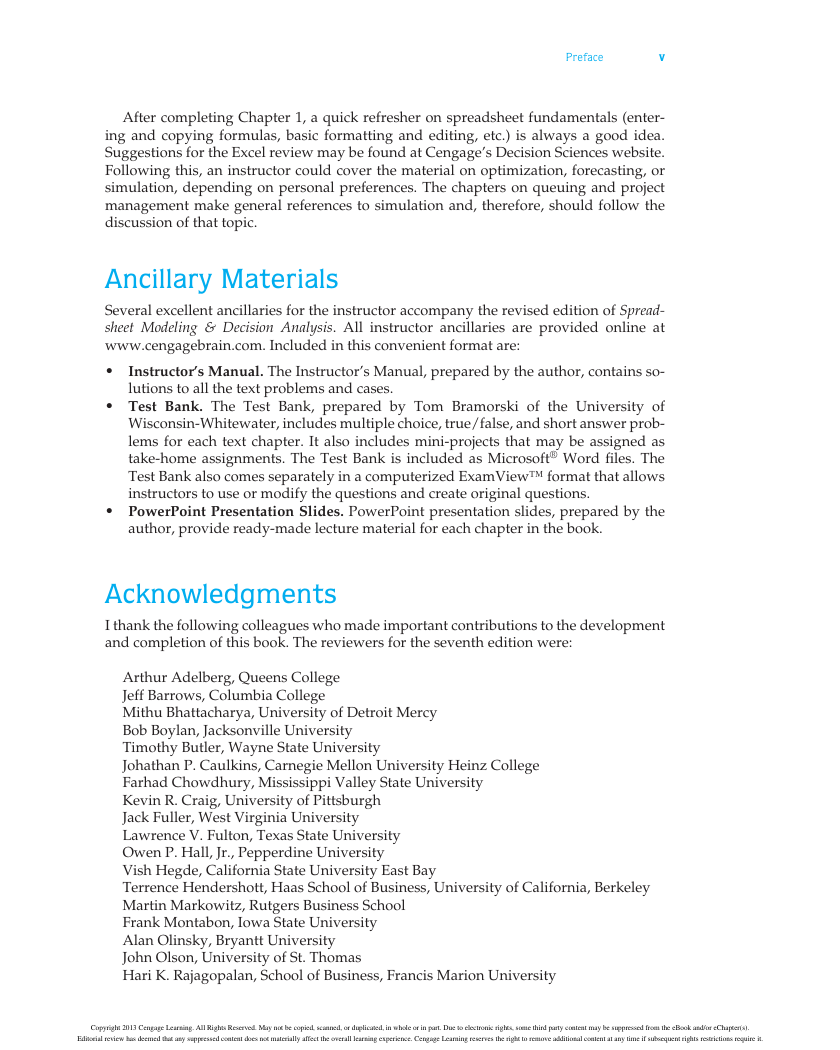
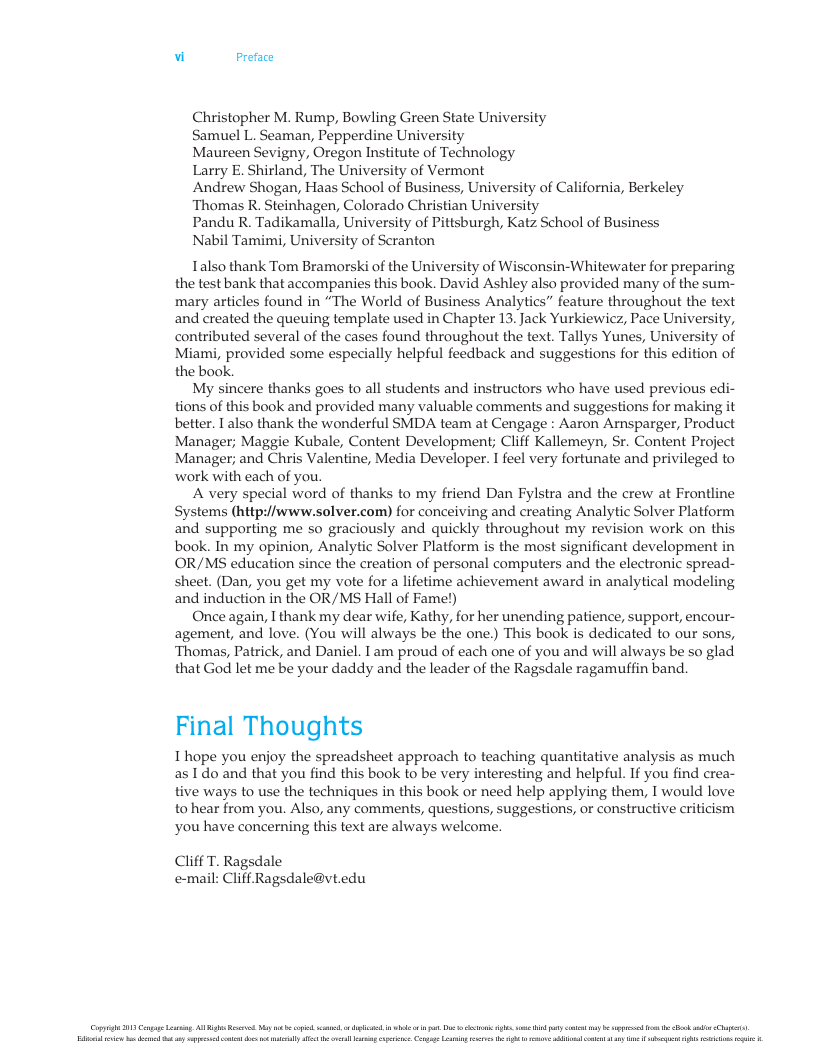








 2023年江西萍乡中考道德与法治真题及答案.doc
2023年江西萍乡中考道德与法治真题及答案.doc 2012年重庆南川中考生物真题及答案.doc
2012年重庆南川中考生物真题及答案.doc 2013年江西师范大学地理学综合及文艺理论基础考研真题.doc
2013年江西师范大学地理学综合及文艺理论基础考研真题.doc 2020年四川甘孜小升初语文真题及答案I卷.doc
2020年四川甘孜小升初语文真题及答案I卷.doc 2020年注册岩土工程师专业基础考试真题及答案.doc
2020年注册岩土工程师专业基础考试真题及答案.doc 2023-2024学年福建省厦门市九年级上学期数学月考试题及答案.doc
2023-2024学年福建省厦门市九年级上学期数学月考试题及答案.doc 2021-2022学年辽宁省沈阳市大东区九年级上学期语文期末试题及答案.doc
2021-2022学年辽宁省沈阳市大东区九年级上学期语文期末试题及答案.doc 2022-2023学年北京东城区初三第一学期物理期末试卷及答案.doc
2022-2023学年北京东城区初三第一学期物理期末试卷及答案.doc 2018上半年江西教师资格初中地理学科知识与教学能力真题及答案.doc
2018上半年江西教师资格初中地理学科知识与教学能力真题及答案.doc 2012年河北国家公务员申论考试真题及答案-省级.doc
2012年河北国家公务员申论考试真题及答案-省级.doc 2020-2021学年江苏省扬州市江都区邵樊片九年级上学期数学第一次质量检测试题及答案.doc
2020-2021学年江苏省扬州市江都区邵樊片九年级上学期数学第一次质量检测试题及答案.doc 2022下半年黑龙江教师资格证中学综合素质真题及答案.doc
2022下半年黑龙江教师资格证中学综合素质真题及答案.doc